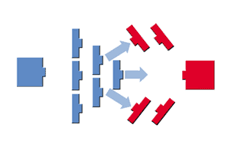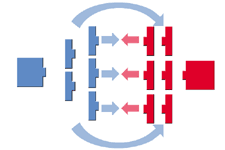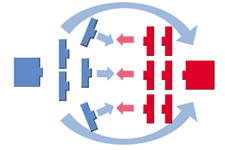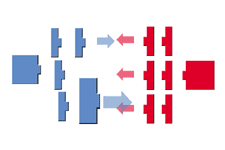

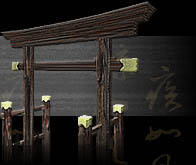

Basic Strategies
In the history of warfare, there are certain basic strategic maneuvers that commanders have tried to use in order to win on the battlefield. Since the AI in Takeda has been programmed to make use of these maneuvers, the player can greatly benefit by learning a thing or two about the basics of battlefield combat. With some practice, the player will learn how to implement these maneuvers him or herself, and even to anticipate the opponent (whether human or computer).
The basic strategies used in Takeda are as follows:
This straightforward attack strategy works pretty much like it sounds. When the enemy has taken a defensive stance (usually by forming a large line across the battlefield), your best bet is to concentrate your forces and attack a single spot.
In a center penetration strategy, many divisions are sent to attack a single point in the enemy line. Even against superior numbers, a concentrated attack can outmatch the enemy in a specific location, and the enemy line will eventually crack. Once that happens, you will have a free path to begin attacking the enemy HQ and to flank the other divisions in the defense line.
Flanking
Sun Tzu said that it was best to avoid attacking a strong enemy head on. If possible, attack him from the side. This only makes sense – many animals have extremely powerful defenses against frontal attacks, but are comparatively weak from the sides or rear. The same is true of armies. If you can get around the main enemy force, you can attack their HQ, or get their divisions from the side or from behind where they cannot defend.
The best way to implement this kind of strategy is to use a strike detachment. The strike detachment can attack the enemy HQ while your main army engages and distracts the enemy. Or, it can work the other way around – you can wait for your detachment to distract the enemy before rallying a main assault.
Envelopment
Probably the best way to deal with an enemy is to surround him. If you can get the enemy army – or even a big part of it – caught between several of your divisions, then you will have a serious advantage. Not only can you attack from all sides, but the enemy is also without an escape route, and will not receive any outside aid.
Quite often an envelopment strategy can be used when the enemy has taken the initiative. You can wait for the enemy to attack, and while he is busy doing that, part of your army can circle around behind and cut him off.
Oblique
An oblique attack strategy works much like a bulldozer. Your army forms an angled line, with one end closer to the enemy than the other. This line then moves forward all at once. The leading edge of the line will bear the brunt of the attack, but enemy divisions will have to face fresh divisions as they are “pushed” along the line. Essentially, the enemy divisions are constantly flanked, and thus more easily defeated.
